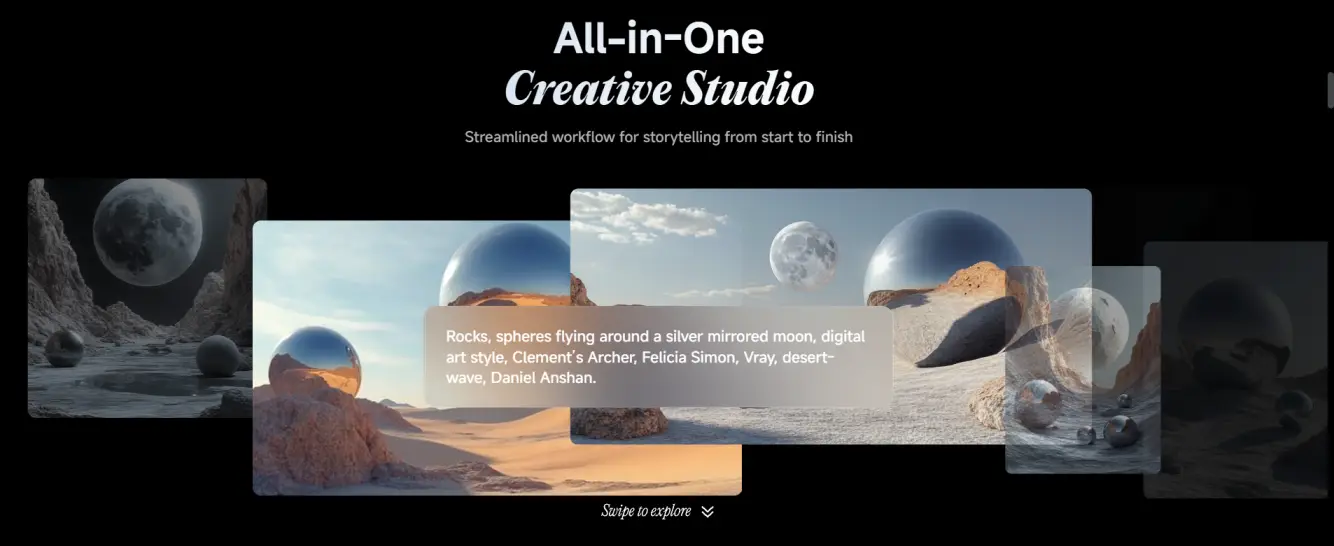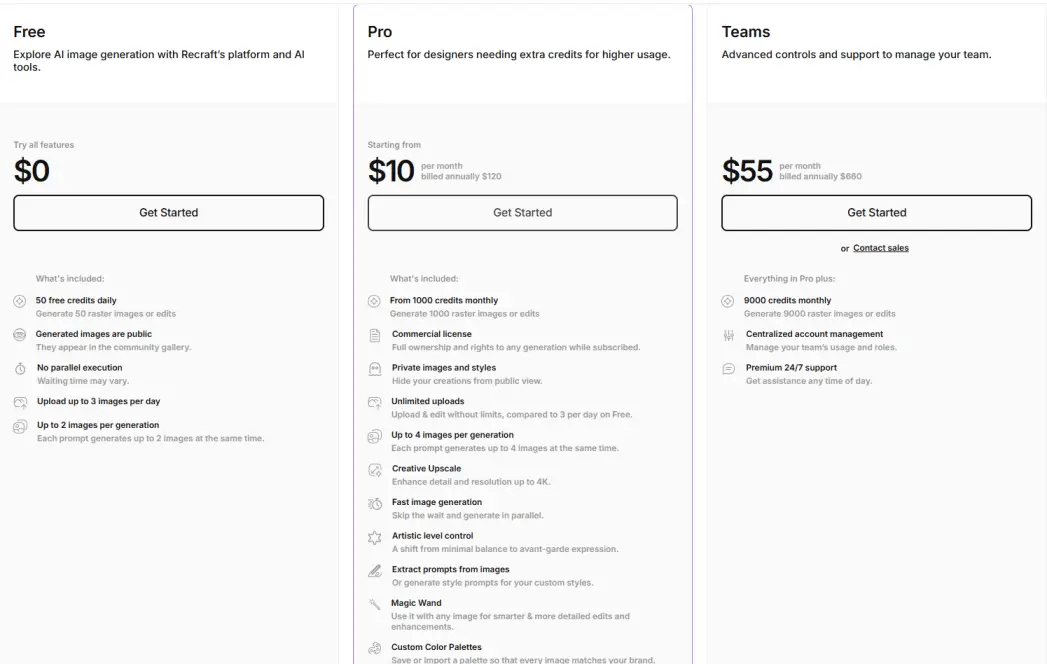Best AI Image Generators 2025 – Top Tools for Designers, Creators & Visual Thinkers
AI image generators have become essential creative tools in 2025, empowering designers, marketers, educators, and hobbyists to produce stunning visuals from simple text prompts. These platforms use advanced models like diffusion networks, transformers, and proprietary engines to generate illustrations, mockups, logos, and photorealistic scenes in seconds.
CortexLab reviews the top AI image generators with a focus on usability, output quality, customization, and ethical transparency. Whether you’re building brand assets or exploring visual storytelling, these tools offer powerful features for every creative workflow.
Kling AI – Next-Gen Studio for Video & Image Creation
Kling AI is a next-generation creative studio powered by cutting-edge generative models. It supports both image and video generation, making it one of the few platforms that seamlessly bridge static visuals and motion design. Built for professionals and creatives alike, Kling AI transforms written prompts into cinematic videos, high-resolution images, and even 3D-style compositions — all with minimal effort.
Whether you're visualizing futuristic architecture, animating product concepts, or crafting digital art, Kling AI offers:
-
🎨 AI-powered image creation with prompt-based control and reference uploads
-
🎥 Text-to-video generation with realistic motion, lighting, and scene transitions
-
📐 Flexible aspect ratios for social media, presentations, and commercial use
-
⚙️ Creative workspace with resolution settings, batch generation, and asset management
Kling AI is ideal for:
-
Designers building visual prototypes or moodboards
-
Marketers creating short-form video content for campaigns
-
Educators visualizing abstract concepts in motion
-
Content creators producing AI-enhanced media for YouTube, TikTok, or blogs
-
Studios testing generative workflows for animation and storytelling
With support for up to 1080p video, 30fps frame rate, and multilingual prompts, Kling AI is redefining how creators interact with generative technology. It’s not just a tool — it’s a full creative ecosystem for modern visual production

Pros:
- Supports both image and video synthesis
- API access for developers and studios
- Mobile app available
- Clean interface and global reach
Cons:
- Limited public documentation
- No built-in editing or vector tools
- Focused more on enterprise than casual users
Best For:
Creative studios, developers, and content teams looking to integrate AI visuals into branded workflows.
Recraft – Designer-Focused Image & Vector Generator
⏩Sign up for Recraft Now
Recraft AI is a design-focused generative platform built specifically for creatives who need precision, flexibility, and speed. It offers text-to-image generation, vector export, mockup creation, and seamless pattern design, all with fine-tuned control over style, layout, and brand consistency.

Who is Recraft for?
-
Graphic designers looking to generate icons, illustrations, and branded assets without relying on complex software
-
Marketing teams creating high-converting visuals for ads, social media, and product launches
-
Content creators who want unique, on-brand graphics for blogs, videos, and presentations
-
UX/UI designers prototyping interfaces and generating visual components on the fly
-
Startup founders building pitch decks, logos, and visual identities quickly and affordably
-
Educators and e-learning developers producing infographics, diagrams, and teaching materials
⚙️ Key Features:
-
Prompt-based image and vector generation
-
Export to SVG and other high-quality formats
-
Mockup builder for branding and product visualization
-
Seamless pattern design with editable elements
-
Style presets: flat, 3D, minimal, illustrative, iconographic
-
Brand palette and typography control for consistent output
Recraft AI isn’t just a tool — it’s a creative engine that empowers designers to move from concept to execution in minutes. Whether you're building a brand, launching a campaign, or teaching a concept, Recraft delivers professional-grade visuals with AI speed.
.Stable Diffusion Web – Open-Source Power with Prompt Control
Overview:
Stable Diffusion Web offers free access to the powerful SDXL model. It supports photorealistic generation, inpainting, outpainting, and prompt-based customization.
Pros:
- Free to use with no login
- Massive prompt database (9M+)
- Supports SDXL Turbo for real-time generation
- Commercial use allowed under permissive license
Cons:
- No built-in editing tools
- Requires strong prompt-writing skills
- UI is minimalistic and not beginner-friendly
Best For:
Artists, researchers, and prompt engineers who want full control over image generation.
Flux AI – High-Resolution Generator with Model Variants
Overview:
Flux AI offers multiple model variants (Pro, Dev, Schnell) for different use cases. It supports text-to-image, image-to-image, and advanced prompt adherence with high-resolution output.
Pros:
- Free credits for registered users
- Supports up to 2MP resolution
- Diverse styles and aspect ratios
- API and open-weight access
Cons:
- Some prompts may lean toward stylized or niche aesthetics
- UI can be overwhelming for new users
- Commercial features gated behind subscription
Best For:
Creators, developers, and visual storytellers seeking high-quality, customizable AI images.
Ideogram – Minimalist Generator for Quick Inspiration
Overview:
Ideogram is a lightweight platform focused on fast image generation and idea exploration. It’s ideal for casual users and concept sketching.
Pros:
- Simple interface
- Quick generation speed
- No technical barrier to entry
- Good for moodboards and visual brainstorming
Cons:
- Limited customization
- No vector or editing tools
- Requires sign-in for full access
Best For:
Students, hobbyists, and marketers looking for fast visual inspiration.
What Is an AI Image Generator?
An AI image generator is a software tool that uses artificial intelligence—typically deep learning models like diffusion networks or transformers—to create images from text prompts or other inputs. These tools can produce illustrations, logos, mockups, photorealistic scenes, and abstract art with minimal manual effort.
Modern AI image generators are used across industries:
- Designers use them for branding, icons, and UI assets
- Marketers generate visuals for ads and social media
- Educators create diagrams and visual aids
- Artists explore new styles and compositions
- Developers integrate them into creative apps and workflows
CortexLab reviews these platforms to help users choose tools that align with their goals, ethics, and creative needs.
FAQ – AI Image Generators Explained
What is the difference between text-to-image and image-to-image generation?
Text-to-image uses prompts to create visuals from scratch. Image-to-image modifies or enhances existing images using AI.
Can I use AI-generated images commercially?
Most platforms allow commercial use, but licensing varies. Always check the terms of service.
Do I need design skills to use these tools?
No. Many platforms are beginner-friendly, though prompt-writing and visual literacy help improve results.
Are AI image generators safe to use?
Yes, when used ethically. Avoid generating misleading, harmful, or copyrighted content without permission.
Which generator is best for branding and logos?
Recraft is optimized for brand-safe outputs and vector export, making it ideal for professional design.
Creative Responsibility Reminder
All AI image generators listed are reviewed for educational and creative purposes. CortexLab encourages responsible use of generative tools, including respect for copyright, privacy, and platform guidelines.
Disclaimer: This article is for informational purposes only. CortexLab does not host, promote, or distribute AI-generated content. All tools reviewed are publicly available and subject to their own terms of service.